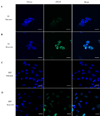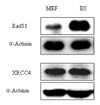DNA repair in murine embryonic stem cells and differentiated cells
- PMID: 18374918
- PMCID: PMC2532524
- DOI: 10.1016/j.yexcr.2008.02.007
DNA repair in murine embryonic stem cells and differentiated cells
Abstract
Embryonic stem (ES) cells are rapidly proliferating, self-renewing cells that have the capacity to differentiate into all three germ layers to form the embryo proper. Since these cells are critical for embryo formation, they must have robust prophylactic mechanisms to ensure that their genomic integrity is preserved. Indeed, several studies have suggested that ES cells are hypersensitive to DNA damaging agents and readily undergo apoptosis to eliminate damaged cells from the population. Other evidence suggests that DNA damage can cause premature differentiation in these cells. Several laboratories have also begun to investigate the role of DNA repair in the maintenance of ES cell genomic integrity. It does appear that ES cells differ in their capacity to repair damaged DNA compared to differentiated cells. This minireview focuses on repair mechanisms ES cells may use to help preserve genomic integrity and compares available data regarding these mechanisms with those utilized by differentiated cells.
Figures


References
Publication types
MeSH terms
Grants and funding
LinkOut - more resources
Full Text Sources
Other Literature Sources

